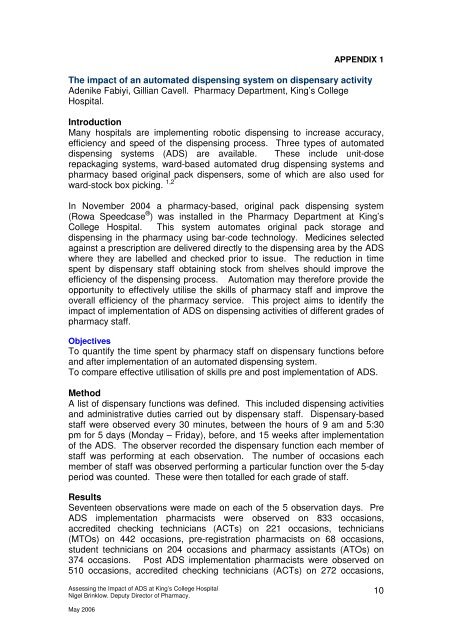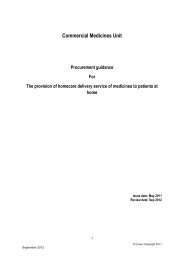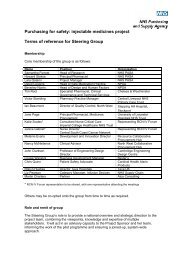A Report Assessing the Impact of an Automated Dispensing System ...
A Report Assessing the Impact of an Automated Dispensing System ...
A Report Assessing the Impact of an Automated Dispensing System ...
You also want an ePaper? Increase the reach of your titles
YUMPU automatically turns print PDFs into web optimized ePapers that Google loves.
<strong>Assessing</strong> <strong>the</strong> <strong>Impact</strong> <strong>of</strong> ADS at King’s College Hospital<br />
Nigel Brinklow. Deputy Director <strong>of</strong> Pharmacy.<br />
May 2006<br />
APPENDIX 1<br />
The impact <strong>of</strong> <strong>an</strong> automated dispensing system on dispensary activity<br />
Adenike Fabiyi, Gilli<strong>an</strong> Cavell. Pharmacy Department, King’s College<br />
Hospital.<br />
Introduction<br />
M<strong>an</strong>y hospitals are implementing robotic dispensing to increase accuracy,<br />
efficiency <strong>an</strong>d speed <strong>of</strong> <strong>the</strong> dispensing process. Three types <strong>of</strong> automated<br />
dispensing systems (ADS) are available. These include unit-dose<br />
repackaging systems, ward-based automated drug dispensing systems <strong>an</strong>d<br />
pharmacy based original pack dispensers, some <strong>of</strong> which are also used for<br />
ward-stock box picking. 1,2<br />
In November 2004 a pharmacy-based, original pack dispensing system<br />
(Rowa Speedcase ® ) was installed in <strong>the</strong> Pharmacy Department at King’s<br />
College Hospital. This system automates original pack storage <strong>an</strong>d<br />
dispensing in <strong>the</strong> pharmacy using bar-code technology. Medicines selected<br />
against a prescription are delivered directly to <strong>the</strong> dispensing area by <strong>the</strong> ADS<br />
where <strong>the</strong>y are labelled <strong>an</strong>d checked prior to issue. The reduction in time<br />
spent by dispensary staff obtaining stock from shelves should improve <strong>the</strong><br />
efficiency <strong>of</strong> <strong>the</strong> dispensing process. Automation may <strong>the</strong>refore provide <strong>the</strong><br />
opportunity to effectively utilise <strong>the</strong> skills <strong>of</strong> pharmacy staff <strong>an</strong>d improve <strong>the</strong><br />
overall efficiency <strong>of</strong> <strong>the</strong> pharmacy service. This project aims to identify <strong>the</strong><br />
impact <strong>of</strong> implementation <strong>of</strong> ADS on dispensing activities <strong>of</strong> different grades <strong>of</strong><br />
pharmacy staff.<br />
Objectives<br />
To qu<strong>an</strong>tify <strong>the</strong> time spent by pharmacy staff on dispensary functions before<br />
<strong>an</strong>d after implementation <strong>of</strong> <strong>an</strong> automated dispensing system.<br />
To compare effective utilisation <strong>of</strong> skills pre <strong>an</strong>d post implementation <strong>of</strong> ADS.<br />
Method<br />
A list <strong>of</strong> dispensary functions was defined. This included dispensing activities<br />
<strong>an</strong>d administrative duties carried out by dispensary staff. Dispensary-based<br />
staff were observed every 30 minutes, between <strong>the</strong> hours <strong>of</strong> 9 am <strong>an</strong>d 5:30<br />
pm for 5 days (Monday – Friday), before, <strong>an</strong>d 15 weeks after implementation<br />
<strong>of</strong> <strong>the</strong> ADS. The observer recorded <strong>the</strong> dispensary function each member <strong>of</strong><br />
staff was performing at each observation. The number <strong>of</strong> occasions each<br />
member <strong>of</strong> staff was observed performing a particular function over <strong>the</strong> 5-day<br />
period was counted. These were <strong>the</strong>n totalled for each grade <strong>of</strong> staff.<br />
Results<br />
Seventeen observations were made on each <strong>of</strong> <strong>the</strong> 5 observation days. Pre<br />
ADS implementation pharmacists were observed on 833 occasions,<br />
accredited checking technici<strong>an</strong>s (ACTs) on 221 occasions, technici<strong>an</strong>s<br />
(MTOs) on 442 occasions, pre-registration pharmacists on 68 occasions,<br />
student technici<strong>an</strong>s on 204 occasions <strong>an</strong>d pharmacy assist<strong>an</strong>ts (ATOs) on<br />
374 occasions. Post ADS implementation pharmacists were observed on<br />
510 occasions, accredited checking technici<strong>an</strong>s (ACTs) on 272 occasions,<br />
10






